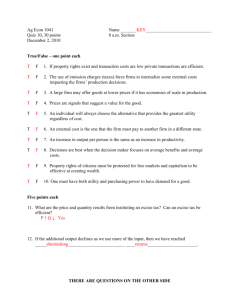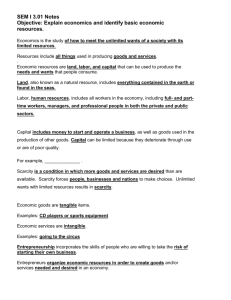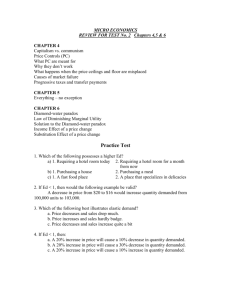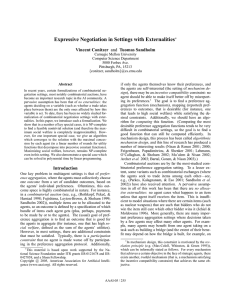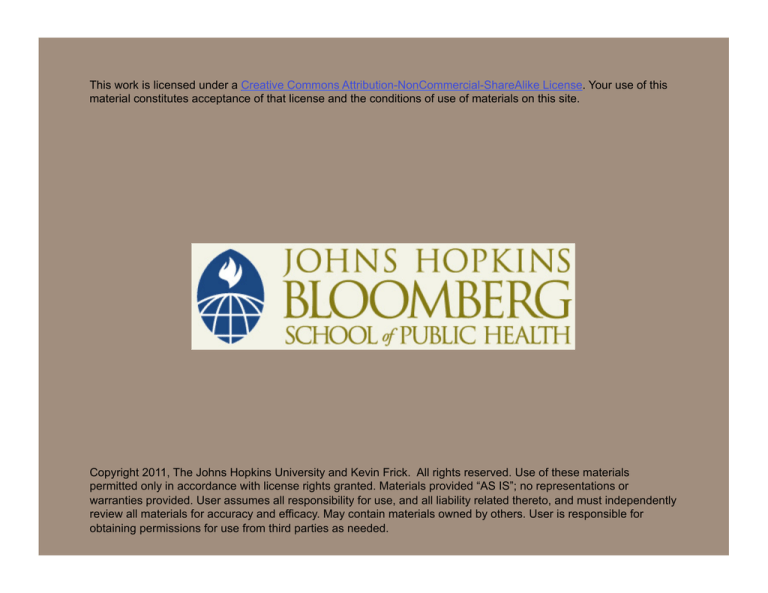
This work is licensed under a Creative Commons Attribution-NonCommercial-ShareAlike License. Your use of this
material constitutes acceptance of that license and the conditions of use of materials on this site.
Copyright 2011, The Johns Hopkins University and Kevin Frick. All rights reserved. Use of these materials
permitted only in accordance with license rights granted. Materials provided “AS IS”; no representations or
warranties provided. User assumes all responsibility for use, and all liability related thereto, and must independently
review all materials for accuracy and efficacy. May contain materials owned by others. User is responsible for
obtaining permissions for use from third parties as needed.
Section B
Some Basic Economic Concepts
Economic Concepts and Terminology
Utility
Marginal analysis
Supply and demand
Quantity supplied and quantity demanded
Economies of scale
Externalities
Time cost
Elasticity of demand
3
Utility
Individuals are thought to try to maximize utility
- Well-being
-
Happiness
Economists do not presume to tell individuals . . .
-
-
What should be included in their utility
How they should weight different attributes in their utility
function
Economists would like to observe behavior to infer something about
people’s utility functions
Each of us weighs health relative to other aspects of consumption
and behavior differently and may care about different components
of health differently
4
Marginal Analysis
How to spend the next dollar
- Gym membership, healthier food, movie night
How to use the last hour available
- Housework, leisure, employment, exercise, healthier food
preparation
How much will it cost to produce the next visit
- What type of provider?
-
-
-
What type of patient?
What time of day?
Where?
5
Supply and Demand
Supply describes the relationship between the price at which a good
is sold and the quantity that will be produced
Demand describes the relationship between the price at which a
good is bought and the quantity that will be purchased
In a perfectly competitive market the curves that describe these
will cross at a point of equilibrium
Fast food—suppose the United States imposes a tax on fast food
- At a higher price
More would be produced if the producer kept the money
but the producer does not keep the tax
Less will be consumed
The equilibrium without a tax may be “just the right amount”
as it is determined by the two sets of tradeoffs
-
6
Quantity Supplied and Quantity Demanded
Technical distinction between supply and quantity supplied (same
for demand)
Quantity supplied
-
Changes in the quantity supplied imply movements along the
supply curve
-
Contrast with change in supply
Something exogenous to the quantity and price of the good
in question changes and the supply curve shifts
Quantity demanded—analogous
If an employer provides a subsidy for a gym membership, more
people will join the gym
7
Economies of Scale
The unit price of production goes down as the quantity produced
increases
Organic food production may be at a lower unit cost as more organic
food is produced
Processed food production is almost always at a lower cost when
more is produced
8
Externalities
Effects of a transaction on individuals other than the buyer or seller
Getting a vaccination protects more than the person who received
the vaccination
Are there externalities of obesity?
9
Time Costs
Time is valuable
We often hear the expression “if there were only more hours in the
day”
What is time worth?
Health behaviors that require more time are less likely to occur
Multiple demands on our time
- Preparing healthy foods, earning money, leisure, parenting,
exercise, etc.
10
Elasticity of Demand
The relationship between the changes in price and the changes in
quantity
-
Percentage changes
A one percent change in price implies . . .
- Less than a 1% change in quantity (inelastic)
- Exactly a 1% change in quantity (unitary elastic)
- More than a 1% change in quantity (elastic)
The more elastic the demand for a good, the more that taxing or
subsidizing a good will create a negative welfare impact
11



